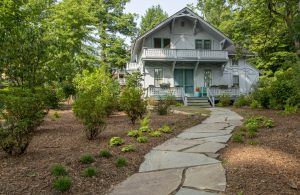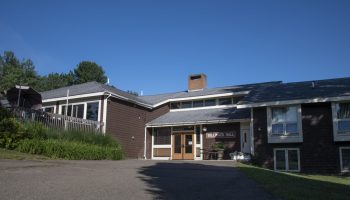
The story of the gardens at the Miller Edison Cottage is both a century old and just beginning.
In 1922, Mina Miller Edison, the daughter of Chautauqua Institution co-founder Lewis Miller, hired a landscape architect to design the gardens around the cottage where she had spent her summers at Chautauqua as a child.
That architect, Ellen Biddle Shipman, was one of the few women in her field at the time. She drew up a detailed plan that crammed a few thousand plants into the space around the cottage.
Nearly a century later, the gardens have been reimplemented according to Shipman’s original plans, with some adjustments, thanks to a collaboration between the Chautauqua Foundation; Supervisor of Gardens and Landscapes Betsy Burgeson; and the Bird, Tree & Garden Club.
“It’s the living garden that connects the beginning of Chautauqua with now,” said Sara Baker Michalak, as she guided a BTG-organized tour of the gardens on July 24.
A Revival
This project was initially made possible when Tom Hagen donated the cottage, located at 24 Miller Park, to the Chautauqua Foundation in 2016, after purchasing it from Lewis Miller’s great-grandson, Ted Arnn.
The Institution’s archivist, Jon Schmitz, dug up the original 1922 plans for the garden, along with receipts that detailed the plants that were purchased for the garden’s initial installation. One receipt, for more than 300 perennials, came to a total of $31, Burgeson said.
The Foundation board hired Connecticut-based firm, Heritage Landscapes, to review the plans and provide guidance for the project. Though the Chautauqua Institution Historic District is listed on the National Register of Historic Places, the Miller Edison Cottage is the only individual building on the grounds designated as a National Historic Landmark.
The original plans for the cottage’s gardens were incredibly ambitious, including three to four thousand plants in the design. The number of plants was halved for the reboot of the garden in order to prevent overcrowding. Project partners also modified the plan to introduce native plants in place of invasive ones.
“We really tried hard to, anywhere we could, put plants in where they were located based on the 1922 plans,” Burgeson said. “If the conditions weren’t right for it now, we tried putting in something that was similar in structure, texture, color and blooming time.”
Burgeson also added some rain gardens in the plan in order to address low spots that would accumulate water. These gardens are comprised of gravel and plants she and her crew installed to help water soak into the ground.
Baker Michalak pointed out one of those rain gardens on the July 24 tour.
“(Burgeson) is upgrading with what we know now and integrating these ideas into the current garden,” Baker Michalak said. “She’s directing the water here in a very natural way.”
Last fall, Burgeson and her crew dug out about 400 plants from the garden and nurtured them in a greenhouse throughout the winter. Three hundred survived and were replanted in the garden this year.
Burgeson said the project was delayed about a month because this year’s unusually rainy spring made it difficult to complete hardscaping, such as fountain repairs, laying stones and the implementation of a new retaining wall. As the first Chautauquans arrived at the beginning of the season, Burgeson and her crew rushed to plant the space.
“We’ve all kind of gotten used to the fact that when Betsy starts a new garden, there is initial destruction and a mushroom cloud,” BTG President Angela James said on July 30, at a Foundation event honoring donors who contributed to the project.
That initial destruction has quickly transformed into peaceful beauty.
In the fall, Burgeson and her crew will plant ferns, bulbs and woodland plants, such as woodland orchids.
“If landscape design is about ‘right plant, right place,’ we did that concept one better with the right person of Betsy Burgeson,” James said.
The Cottage
Lewis Miller, an accomplished inventor who patented the design for the horse-drawn buckeye mower, co-founded the Chautauqua Lake Sunday School Assembly in 1874, with Bishop John Heyl Vincent.
Miller and his wife, Mary Valinda Miller, had 11 children, according to a booklet on the cottage written by Jeffrey Simpson, who died in August last year.
In 1875, Miller had a cottage built to house his family during their summers at Chautauqua. He and his wife slept in a bedroom on the ground floor; the girls slept on the second floor; and the boys slept in a large tent on a porch that used to be attached to the right side of the building, Simpson wrote.
Miller entertained guests such as Presidents Rutherford B. Hayes and Ulysses S. Grant in the late 1800s. Miller died in 1899, and the cottage was used by various family members until his daughter, Mina Miller Edison, purchased it in 1920 from her younger brother, John.
Mina had married Thomas Edison — who was 39 and a widower at the time — in 1886 at the age of 20.
Mina renovated the cottage, opening up the first floor to create a large living room that runs from the front to the back of the house. The gardens can be seen from the front door out the big French doors in the back. In 1922, she commissioned Shipman to design the cottage’s gardens.
Shipman encouraged the Edisons to purchase a rooming house on the hill behind their home, so they could knock it down and Shipman could use the foundation as the back wall of the garden.
“(Shipman) said all of the structure in your garden is the skeleton upon which you plant your whole place,” said Marta McDowell, an instructor at the New York Botanical Garden in the Bronx, and author of books on historic gardens. “If you think about Miller Cottage and the structure with all of the walkways and the patio, that was the skeleton. And she wanted to fill it with flowers.”
The Architect
Shipman began her gardening career out of necessity. At the age of 40, her husband, Louis Shipman, left her and their three children for a new girlfriend and a new life in London, said McDowell, who also assisted with the reconstruction of the gardens at the cottage.
Charles Platt, an architect who was her neighbor in Cornish, New Hampshire, took Shipman under his wing. His apprentices taught her the technical side of landscaping — including how to draft plans — which she did not yet know how to do, despite keeping up a remarkable garden at her home.
Shipman previously studied landscape architecture at the Harvard Annex, Harvard University’s women’s college at the time. But she never finished her education because she and her college sweetheart, Louis Shipman, who had studied at Harvard, decided to run away together and get married.
“In the 19th century, gardening was something that was really the purview of the men of the household,” McDowell said at the BTG’s annual life member luncheon on Aug. 2. “It was a proper gentleman’s occupation. Around the end of the 1800s, that started to change.”
Shipman was one of the few female landscape architects of her time. There were very few opportunities for women to learn the craft.
“She later said that the reason she and other women were so good at creating gardens is because they learned by gardening first, and then working on the drafting boards later,” McDowell said.
As Shipman became more established, she only hired women, many of whom were graduates of the Lowthorpe School of Landscape Architecture in Groton, Massachusetts. Many went on to start their own successful businesses.
The majority of Shipman’s clients were wealthy women, McDowell said, since they had control over their gardens and the means to hire someone to design them. After Shipman had worked with a client, she would visit them once or twice a year, and consult on their garden, with room and board provided by the client.
“Ellen Shipman was a great designer,” McDowell said. “She was also a great businesswoman.”
The Garden Today
Because of their complicated natures, very few of Shipman’s gardens still exist; those that do, have been simplified.
“Shipman gardens are notoriously hard to maintain; I’m sorry to tell you that,” McDowell joked at the BTG luncheon. “I know you’re just starting out.”
The BTG purchased signs to label the many species of plants in the garden. The BTG also offered tours of the gardens at 1 p.m. every Wednesday this season. Proceeds from the tours have gone to the Chautauqua Foundation endowment for the gardens.
Burgeson said she is eager to see how the gardens will turn out.
“Just like with any garden, it’s the excitement of the next year,” Burgeson said. “I’ve seen how much a garden fills in. It gives you hope for the next year; it gives you something to look forward to.”
Nearly a century later, the garden has been born again.
“I’ll tell you a little story that someone told me,” said McDowell at the July 30 donor event. “She said that any garden takes three years to really show itself. Year one, it sleeps. Year two, it creeps. And year three, it leaps. Keep that in mind, because you are going to see extraordinary things.”




